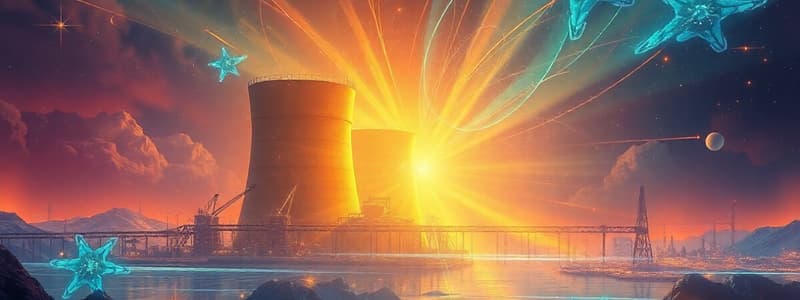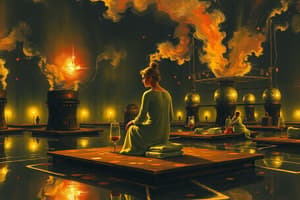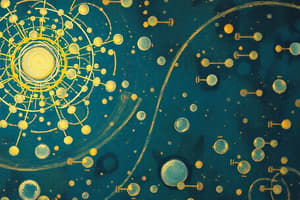Podcast
Questions and Answers
What does the multiplication factor (k) indicate about a reactor's neutron population?
What does the multiplication factor (k) indicate about a reactor's neutron population?
- If k is greater than 1, the number of neutrons is increasing. (correct)
- If k is greater than 1, the chain reaction is diminishing.
- If k equals 1, the reaction is at equilibrium.
- If k is less than 1, the number of neutrons is increasing.
Which factor has the least influence on the neutron cross section for a given material?
Which factor has the least influence on the neutron cross section for a given material?
- System geometry
- Temperature of the reactor (correct)
- Isotopic composition
- Neutron energy
In calculating neutron multiplication, what is primarily tracked through various interactions?
In calculating neutron multiplication, what is primarily tracked through various interactions?
- Mass of fissile materials
- Type of fission event
- Losses through absorption and scattering (correct)
- Energy levels of the neutrons
How does the geometry of a reactor affect neutron calculations?
How does the geometry of a reactor affect neutron calculations?
Which statement about isotopes is true regarding their effect on fission?
Which statement about isotopes is true regarding their effect on fission?
What is a primary consideration for neutron flux calculations in transient conditions?
What is a primary consideration for neutron flux calculations in transient conditions?
What methods are employed for simulating neutrons in calculations?
What methods are employed for simulating neutrons in calculations?
Which element is not a direct factor in neutron multiplication calculations?
Which element is not a direct factor in neutron multiplication calculations?
What is neutron flux primarily expressed in?
What is neutron flux primarily expressed in?
Which factor does the macroscopic cross section NOT account for?
Which factor does the macroscopic cross section NOT account for?
What is the first step in calculating neutron flux?
What is the first step in calculating neutron flux?
Which type of neutron interaction is characterized as producing new elements?
Which type of neutron interaction is characterized as producing new elements?
What does neutron abundance quantify?
What does neutron abundance quantify?
What is required to calculate the reaction rate in neutron interactions?
What is required to calculate the reaction rate in neutron interactions?
In the context of a nuclear reactor, what primarily produces neutrons?
In the context of a nuclear reactor, what primarily produces neutrons?
What determines the varying sensitivities of neutron detection instruments?
What determines the varying sensitivities of neutron detection instruments?
Study Notes
Calculating Neutron Flux and Abundance
- Neutron flux is a measure of the rate at which neutrons pass through a given area per unit time, typically expressed in neutrons per square centimeter per second (n/cm²/s).
- Neutron flux is crucial for nuclear reactor design and operation, influencing neutron reaction rates and power output.
- Determining neutron flux requires neutron detectors; different methods and detectors affect accuracy and precision. Detector sensitivity varies with neutron energy.
- Neutron abundance is the proportion of neutrons in a specific energy range relative to the total, often expressed as a percentage or fraction.
- Calculating neutron flux involves measuring detected neutrons over time, normalizing the count by the detector's effective area and measurement duration.
Calculating Neutron Interactions
- Neutron interaction rates depend on neutron flux and material macroscopic cross section.
- Macroscopic cross section predicts neutron interaction probability with nuclei, considering material composition, neutron energy, and interaction type.
- Reaction rate (neutron-induced nuclear reactions) is calculated using flux and macroscopic cross section, crucial for understanding neutron-material interactions in reactors. Reaction rate is expressed as reactions per unit volume per unit time.
- Neutron interactions include absorption, scattering, and fission; each affects the overall reaction rate differently.
Calculating Neutron Production
- Neutron production in nuclear reactors primarily comes from fission reactions.
- Calculating neutron production involves the number of fission events per unit time and the average number of neutrons released per fission event (ν).
- ν significantly affects reactor criticality. Reactor design aims for stable reactions by carefully regulating neutron production.
- Calculations consider fissile isotopes, their fission characteristics, and their variable fission yields which affect neutron multiplication.
- Neutrons can also be artificially produced by particle accelerators; source characteristics are key for calculating artificially produced neutron production rates.
Calculating Neutron Multiplication
- Multiplication factor (k) determines reactor stability and power output.
- k accounts for the net change in neutrons per generation, affecting the chain reaction.
- k > 1 yields increasing neutrons, sustaining the chain reaction.
- k < 1 yields decreasing neutrons, stopping the chain reaction.
- Calculations track neutron interactions and production, accounting for losses (absorption/scattering) and gains (fission).
- Precise neutron flux measurements at various points are crucial input data.
Factors Affecting Neutron Calculations
- Isotopic composition greatly influences neutron cross sections; differing isotopes have varied absorption and scattering probabilities.
- Neutron energy strongly impacts macroscopic cross sections, demanding specific calculations for different energies (e.g., thermal or fast neutrons).
- System geometry (like reactor core dimensions) shapes flux distribution and reaction rates, often modeled using 2D or 3D neutron simulations.
- Time dependence is significant, especially in transient/unstable conditions. Modeling accurately captures dynamic neutron behavior.
- Accurate input data on material composition, geometry, and neutron energy spectrum is essential for reliable calculations. Parameter variations lead to diverse outcomes.
Studying That Suits You
Use AI to generate personalized quizzes and flashcards to suit your learning preferences.



